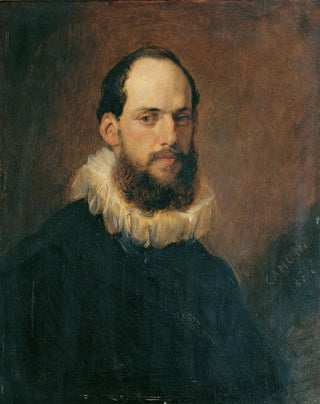Art print | Wilhelm Wartenegg in 17th-century costume - Hans Canon


View from behind

Frame (optional)
In the world of art, some works transcend the simple frame to become windows into bygone eras. The Wilhelm Wartenegg art print in 17th-century costume - Hans Canon is a perfect example. This painting, which immerses us in the heart of the 17th century, evokes not only the aesthetics of its time but also the cultural identity of an era marked by profound changes. Through the delicate features and the flamboyant costume of Wartenegg, the piece invites us to explore a rich past full of stories and traditions. This portrait, rendered with finesse, captures the very essence of aristocracy of yesteryear, transporting us to an age where appearance was synonymous with status and power.
Style and uniqueness of the work
Hans Canon's work stands out for its attention to detail and its ability to bring textures of fabrics and ornaments to life. In this art print, the 17th-century costume is not only a clothing choice but a true symbol of an era. The rich colors and elaborate patterns testify to an exceptional artisanal craftsmanship, while the subject's expression reveals rare psychological depth. Every brushstroke seems to tell a story, every shadow and light emphasizes Wilhelm Wartenegg's personality. The piercing gaze of the figure, fixed on the viewer, creates an intimate connection, a silent exchange between the past and the present. This work is a celebration of the individual, while also reflecting the social and aesthetic norms of its time.
The artist and his influence
Hans Canon, an artist of Austrian origin, marked his era with his ability to fuse realism with a touch of romanticism. Trained in the great traditions of painting, he established himself as a preferred portraitist, capturing the essence of his models with striking precision. Canon evolved within a rich artistic context, influenced by masters such as Rubens and Van Dyck, while developing a style that was uniquely his own. His approach to portraiture, blending psychology and aesthetics, inspired many artists of his time and left a lasting imprint in the art world. By depicting notable figures of his era, he not only documented history

Matte finish

View from behind

Frame (optional)
In the world of art, some works transcend the simple frame to become windows into bygone eras. The Wilhelm Wartenegg art print in 17th-century costume - Hans Canon is a perfect example. This painting, which immerses us in the heart of the 17th century, evokes not only the aesthetics of its time but also the cultural identity of an era marked by profound changes. Through the delicate features and the flamboyant costume of Wartenegg, the piece invites us to explore a rich past full of stories and traditions. This portrait, rendered with finesse, captures the very essence of aristocracy of yesteryear, transporting us to an age where appearance was synonymous with status and power.
Style and uniqueness of the work
Hans Canon's work stands out for its attention to detail and its ability to bring textures of fabrics and ornaments to life. In this art print, the 17th-century costume is not only a clothing choice but a true symbol of an era. The rich colors and elaborate patterns testify to an exceptional artisanal craftsmanship, while the subject's expression reveals rare psychological depth. Every brushstroke seems to tell a story, every shadow and light emphasizes Wilhelm Wartenegg's personality. The piercing gaze of the figure, fixed on the viewer, creates an intimate connection, a silent exchange between the past and the present. This work is a celebration of the individual, while also reflecting the social and aesthetic norms of its time.
The artist and his influence
Hans Canon, an artist of Austrian origin, marked his era with his ability to fuse realism with a touch of romanticism. Trained in the great traditions of painting, he established himself as a preferred portraitist, capturing the essence of his models with striking precision. Canon evolved within a rich artistic context, influenced by masters such as Rubens and Van Dyck, while developing a style that was uniquely his own. His approach to portraiture, blending psychology and aesthetics, inspired many artists of his time and left a lasting imprint in the art world. By depicting notable figures of his era, he not only documented history






